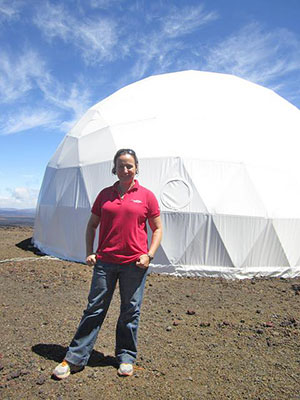By Staff Reports
(Oahu)– The crew that will spend 365 days in isolation in the next Hawaiʻi Space Exploration Analog and Simulation (HI-SEAS) mission has been selected. The six scientists will begin their yearlong stay in the solar powered dome atop Mauna Loa on August 28. It will be the fourth and longest HI-SEAS mission yet in the University of Hawaiʻi at Mānoa research project that simulates long duration space exploration.
As with the previous two HI-SEAS missions in the NASA funded study, this mission will focus on crewmember cohesion and performance. HI-SEAS researchers are working to develop effective team composition and support strategies to allow crews to successfully travel to Mars and back, an estimated three-year journey.
The crew will be monitored using cameras, body movement trackers, electronic surveys, and other methods. UH Mānoa researchers and their collaborators will be studying the group’s cohesion over time, gathering data on a wide range of cognitive, social and emotional factors that may impact team performance.
“The longer each mission becomes, the better we can understand the risks of space travel,” said Kim Binsted, HI-SEAS principal investigator and UH Mānoa professor from the Department of Information and Computer Sciences. “We hope that this upcoming mission will build on our current understanding of the social and psychological factors involved in long duration space exploration and give NASA solid data on how best to select and support a flight crew that will work cohesively as a team while in space.”
2015-2016 HI-SEAS crew members
- Sheyna Gifford has worked on research projects in astrophysics, neuroscience and psychology and is a contributor to NASA educational websites, a medical writer and an advocate of STEM education. Her previous work includes working on the HESSI satellite at Space Science Laboratories. She holds a bachelor of science in neuroscience and english, a master of clinical laboratory science and biotechnology, a master of science in journalism, a doctor of medicine and is currently earning a master of business administration.
- Tristan Bassingthwaighte is currently a doctor of architecture candidate at UH Mānoa. He is in the final stage of completing his master’s degree in architecture from Tongji University in Shanghai, where he studied abroad for a year looking at human habitation in extreme environments. His doctoral work will involve designing a next generation conceptual Mars habitat.
- Carmel Johnston is a soil scientist from Whitefish, Montana. Her previous research focused on the effe
- cts of permafrost thaw on trace gas emissions in peatlands. Her interest in global food production and sustainability lead her to HI-SEAS to research food production in Mars simulation. She has a bachelor of science in soil and water science and a master in science in land resources and environmental sciences from Montana State University.
- Andrzej Stewart is an ardent light aircraft pilot and previously worked at Lockheed Martin as an interplanetary flight controller. He’s worked on console for the Spitzer Space Telescope, Mars Odyssey, MRO, MAVEN, Juno and GRAIL. Recently, he served as the flight engineer for the sixth mission of NASA’s Human Exploration Research Analog (HERA), simulating a two-week journey to asteroid 1620 Geographos. He earned a bachelor of science in aerospace engineering from the University of Texas at Austin in 2005 and an SM in aeronautics and astronautics from MIT in 2007.
- Cyprien Verseux is a doctorate student at the University of Rome. He is an astrobiologist working on the search for life beyond Earth and is also an expert in biological life support systems for Mars exploration. Part of his research aims at making human outposts on Mars as independent as possible of Earth, by using living organisms to process Mars’ resources into products needed for human consumption.
- Christiane Heinicke is a German physicist and engineer. Most recently she has worked on sea ice and has also gained experience working with polar lights, metal melts and simulations of the Earth’s mantle. She received her bachelor of science in applied physics from the Ilmenau University of Technology in Germany and her master of science in geophysics from Uppsala University in Sweden.
In May, NASA awarded HI-SEAS a third grant to keep the research project and its missions funded through 2018.
For more information on the HI-SEAS missions, go to www.hi-seas.org.

